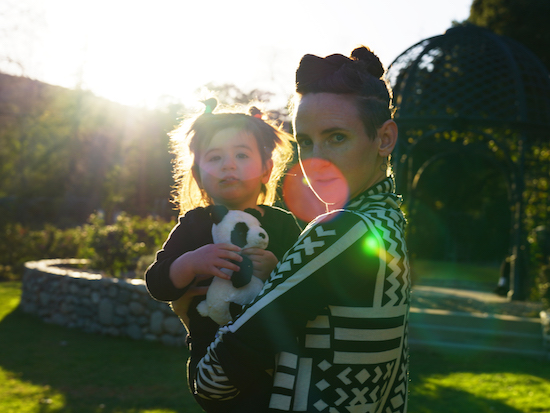Getting to grips with Katie Gately’s music takes time. Eclectic and adventurous, it aims at existing beyond any generic categories. It’s playful and to a certain degree ironic, striking a balance between postmodernism and a new sincerity. Futuristic? Sure. Gately is less interested in crafting tunes than textures. One-dimensional melodies obtain volume with careful arrangement – samples, beats, pads, bits and pieces retrieved from sound libraries feed into an inventive, phantasmagorical facade. This formula has been Gately’s magic charm from the beginning of her musical career when she was spotted (almost immediately) by elements of the music press. Her very first single ‘Pipes’, an ethereal polyphonic composition released on a cassette ten years ago, was described by tQ as “the most eye-opening piece of new music to emerge from the past twelve months”.
From one release to another, Gately has refined her skill to translate life experiences and emotional turbulence into the language of experimental electronic music. While addressing the latest life-changing event, her forthcoming album Fawn/Brute sums up her creative approach. Some elements have become trademark. Familiar single-syllable titles, also present on the first two albums, correspond with a punchy sound, balancing between trip-hop, techno, experimental electronica and hypnotising folk.
Still, Fawn/Brute is born out of the new context. In 2021, Gately gave birth to her first child. Most of the material for the album was recorded during the artist’s pregnancy. Eventually, Gately came up with a concept for the release which would act as a soundtrack to the stages of growing-up.
A love letter to her daughter Quinn, Fawn/Brute nonetheless extends beyond maternal feelings. The album reflects on the period of pregnancy and the first months of parenthood. It runs in chronological order – from the moment of conception (‘Seed’) to declarations of unconditional love on mellow electronic lullaby ‘Melt’. The subject matter that suggests sweeter imagery is treated differently and, perhaps, more realistically. There is a deliberate repetitiveness that might address the long-term prospects of motherhood with its ups and downs. Gately ponders over her experience as a daughter and now a parent, trying to combine both perspectives.
Mother-daughter relationships are not a new theme for Gately whose previous release Loom was composed as a response to the death of a parent. Enfolded in darkness, it could be a soundtrack to a psychodrama session teaching one to deal with feelings of devastating emptiness. A rather difficult listen. Unlike Loom, the new album is pervaded by a vigour that translates into music: the marshy textures of the preceding record give ground to a firmer sound and occasionally unstoppable rhythms akin to the Run Lola Run soundtrack. Samples and vocals express a relentless urge.
As a concept album, Fawn/Brute is well-structured and consistent. As hinted by the title, the record contains two parts, one of which is lighter and more child-like while the second part is darker and more volatile. The name of the album refers to two songs emblematic of such a juxtaposition. Visualised on the cover by images of a harlequin, the two title tracks ‘Fawn’ and ‘Brute’ ostensibly refer to different qualities of a toddler who can be angelic and charming but also capricious and loud. Similarly, the dichotomy addresses two visions of the world – that is by a child and a teenager. ‘Fawn’ is a stomper with bouncing synths and spiralling winds echoing the lighthearted music played at nursery parties or on cartoon soundtracks. It is another example of Gately’s ability to absorb the environment and transform it into an abstract and intangible form. She does it playfully. The second title track ‘Brute’ features a roaring bass line which resulted from the artist’s experiments while producing random sounds with cardboard shoeboxes. It descends into a darker fantasy world with a gloomy waltz-y pace that conjures up Tim Burton’s Sleepy Hollow. (References to soundtracks are endemic throughout Gately’s discography. Having a background in film production, the artist creates music which is imaginative and cinematic. A soundtrack to a contemporary world. At least, to one of them.)
Balancing between light and darkness, Gately doesn’t shy away from anxious feelings. Most of the eleven songs here start with sinister, skidding basslines. On the other hand, each has a depth and emotional complexity that follow acknowledgements of one’s responsibility and feelings to the person who is about to enter the unstable world. A few tracks unfold anxiety triggered by lack of security. ‘Meat’ and ‘Scale’ reflect on the final worrying months of being pregnant. The former starts as a ritual song where tension gradually builds up with layers of synths, vocals and witchy whispering mimicking murmurs of a conversation between members of a hospital staff. The mechanical beats and theremin-esque spooky sounds at the end of the song suggest a matter of life and death. Gately is well-versed in creating suspense and enveloping an intense emotional state into unrestrained electronica. A palimpsest of sounds, ‘Chaw’ starts with a mellow Swan Lake-like intro, sewn into an overwhelming cyberpunk techno.
An auteur with a distinct artistic voice, Gately seems to be in a metaphorical kinship with like-minded experimentalists. Radical Romantics, the latest release by Fever Ray comes to mind and so does, though more distantly, Silicone Veil by Susanne Sundfør. One might detect echoes of Björk, whose song ‘Family’ from 2015’s Vulnicura album was remixed by Gately. The second track on the record, ‘Howl’, nods at Thom Yorke’s solo albums and the pulsating bass in the middle of the song brings to mind Radiohead’s mellow and deeply saddening ‘Nude’. Within its last sixty seconds, it transforms into raving hip-hop.
Still, with this magpie approach, the musician makes a very individual puzzle of sounds. Perhaps, the best analogy would be a mosaic made from fragments of a broken mirror. Fawn/Brute reflects its reality in a distorted and somewhat weird way. It never means to be objective.


